- 27
- Apr
The Complete Smart Lighting Guide – Hot Question Answered!
The Complete Smart Lighting Guide – Hot Question Answered!
The topic of smart lighting is currently receiving widespread attention, from the “smart light app” used by technology enthusiasts to national “smart city lighting” plans. The initial step towards achieving “smart city lighting” involves understanding the hardware features of smart street lights and the software systems governing the smart street lighting. This understanding is essential to successfully implement smart city lighting projects.
In recent news, it was reported that Medina, Saudi Arabia boasts 250 giant parasols, recognized as the world’s largest parasols. These parasols automatically open at sunrise and close at sunset, equipped with temperature control and waterproof features. Interestingly, they also serve as LED landscape lights. The design comes from top German designers, but the manufacturer happens to be an LED light manufacturer based in China. For outdoor commercial lighting companies seeking further information about this fascinating project, You can reach out via email @ me, and I will gladly share the details.
Today, the focus will be on home smart lighting. Lately, I have received numerous requests to write a blog post about “Essential Knowledge of Home Lighting.” As a result, I have compiled some of the most commonly encountered issues faced by enthusiasts in this field.
What is the importance of smart lighting?
What is smart lighting in smart home?
What is traditional lighting vs smart lighting?
What are the disadvantages of smart lighting system?
What are the advantages of smart lighting?
What is the purpose of smart lighting system?
What are the pros and cons of smart lights?
What are the advantages of automated lighting?
what is smart lighting?
what are smart bulbs?
Are smart lights energy efficient?
How do smart bulbs work with switches?
Do smart light bulbs use more electricity?
Smart lighting plays a crucial role in a smart home system. When compared to traditional lighting, intelligent lighting offers various advantages, such as enhanced safety, comfort, higher efficiency, and energy conservation. Currently, intelligent lighting finds its primary applications in public places like upscale hotels, commercial buildings, and exhibition venues. However, with advancements in intelligent lighting research and development, benefits of smart lighting have become more user-friendly, making installation and usage easier. Moreover, the promotion of smart lighting products by major Internet of Things platforms has bridged the gap between smart lighting and ordinary consumers. Now, anyone can create a personalized intelligent lighting system at home and share the benefits of this technology with their family members (see Figure 1).

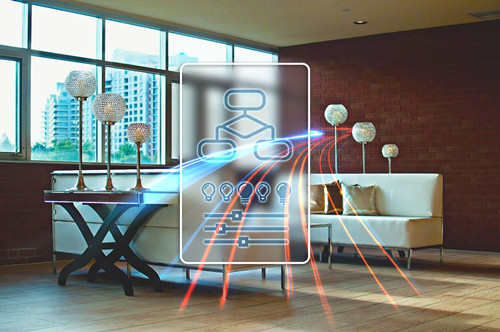
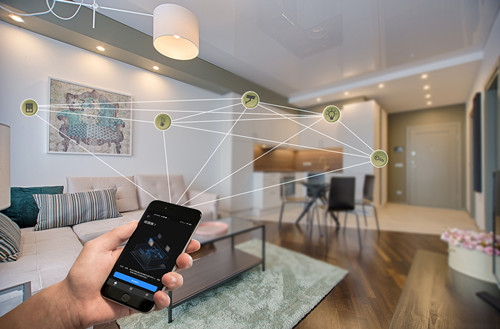
1 Basic Functions of an Intelligent Lighting System
A.Home Lighting Automation Systems
The intelligent dimming function serves as the fundamental feature of intelligent lighting products and is essential when configuring intelligent lighting scenes. The highlighted feature of the intelligent dimming function is “stepless dimming,” allowing users to adjust the brightness, color temperature, and even the color of the light continuously. This versatility offers a wide range of atmospheres and experiences, making it possible to create the desired ambiance for any occasion. Whether it’s a colored light fixture or a standard one, users can seamlessly control the light’s intensity and hue through various means such as the mobile phone control system App, voice-activated speakers, smart dimming switches, remote controls, and control panels (see Figure 2). In different application scenarios, the color temperature and brightness of the light will often vary, and all the scene modes in this article can be applied effectively using the stepless dimming feature.
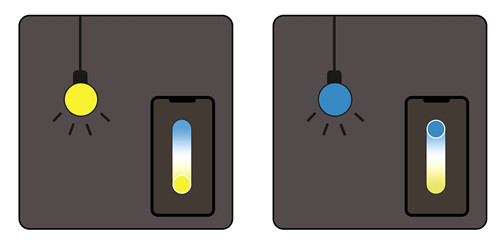
B.Smart Light Fixtures Grouping
As depicted in Figure3, the best home lighting control systems offer not only individual control of lamps but also the ability to manage and operate lamps in batches. This is achieved by grouping lamps through the mobile app. Once the lamps are grouped, you can perform identical operations on the entire group, such as simultaneously turning on or off all the lamps in the group or adjusting their color temperature and brightness collectively. The lamp grouping function is widely used, adding diversity and flexibility to scene designs. Moreover, the grouping principle can be applied to partition the lamps; for instance, you can group all the lamps in the living room and label the space in the app as “living room.” By doing so, you can easily control all the lights in the living room with a single command through the mobile app or other control methods.
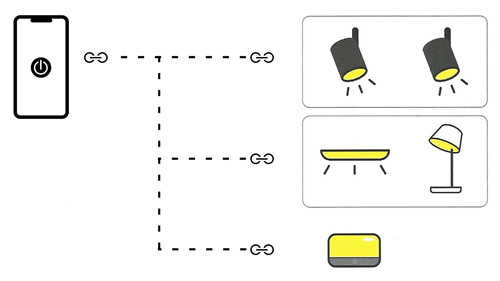
C.Tuya Smart App/ Google Smart Home
The smart linkage solution plays a crucial role in realizing the scene experience of a smart lighting system project. By configuring “no linkage, no intelligence” scenes in the smart field and integrating them with control panels, sensors, and other devices, the system can execute more non-inductive, humanized, and automated intelligent lighting scenes. A common smart lighting linkage scheme involves combining smart lamps with human body sensors, door and window sensors, and other smart home products such as smart speakers, smart door locks, and smart curtains. For instance, by linking the lamps with the door locks and voice speakers, when you arrive home and open the door, the lights from the hallway to the living room will illuminate sequentially, and the voice speakers will warmly greet you with “Welcome Home.” This intelligent linkage method is designed for the “going home” activity (see Figure 4).
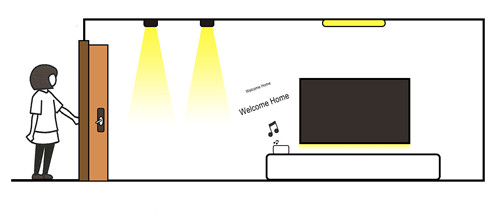
D.Timing and Delay
The timing function of the intelligent lighting system allows users to schedule the activation and deactivation of specific scene modes based on their living habits, eliminating the need for manual triggering. For example, you can set the “sleep aid mode” to automatically turn on at 9 o’clock in the evening, gradually illuminating the bedroom lights to a suitable brightness. Then, as the night progresses, the brightness slowly dims until all lights automatically turn off at 11 o’clock (see Figure 5). Additionally, users can set specific time intervals between lamps or lamp groups. This configuration ensures that when activating certain scenes, the bedroom LED lights will no longer illuminate simultaneously but rather sequentially, enhancing the fun of space lighting modes and creating a sense of ceremony when the lights are turned on.
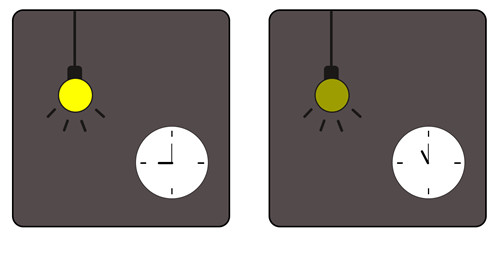
E.Soft Start Function
The soft start function in smart lamps ensures that when the light is turned on, it gradually becomes brighter from darkness, and when turned off, it gradually dims from brightness. This gradual adjustment helps avoid sudden changes in brightness, which could otherwise strain the eyes, providing a gentle transition and safeguarding eyesight. The soft start function proves especially beneficial in situations like getting up at night or attending to babies, where a gradual lighting change is essential.
Moreover, the soft start function prevents the abrupt impact of high current and temperature on the filament, thus protecting the bulb and extending the lamp’s service life. This added feature enhances the overall durability and efficiency of the best home lighting control systems.
F.Daylight Algorithm
An intelligent lighting system should incorporate a “daylight algorithm,” enabling it to calculate the local sunrise and sunset times based on the latitude, longitude, and date of the location. When the “wake-up mode” is activated at sunrise, the color temperature and brightness of the lights synchronize with the natural light. Similarly, at sunset, the lights simulate the color temperature and brightness of dusk (Figure 6). By replicating the changes of natural light, indoor lighting adapts to the rhythm of daylight, complemented by the opening and closing of smart curtains. This creates a comfortable lighting environment that aligns with our daily life patterns.
An alternative approach to simulate sunlight involves using a light sensor to adjust indoor lighting appropriately based on the natural light outside. This method ensures that the indoor lighting remains in harmony with the changing outdoor light conditions.
2 Why Choose Smart Lighting
The primary objective of an intelligent lighting system is to provide people with a safe, comfortable, convenient, and efficient light environment, enhancing their overall sense of happiness in life. Smart lighting systems effectively address the drawbacks of traditional lighting and offer various advantages in terms of functionality, ease of use, and human-computer interaction. A professional and advanced home intelligent lighting system showcases the following key characteristics and advantages, encompassing product installation, system configuration, and user experience:
A.Easy and Fast Installation
The hardware components of the intelligent lighting system mainly include intelligent lamps, smart switches, sensors, control panels, etc. Most products are straightforward to install and can be used immediately. Presently, the most convenient smart lighting products utilize BLE (Bluetooth Low Energy) Mesh wireless transmission protocol for control, transforming the wired control typical in traditional lighting design into wireless control (Figure 7). Wireless control significantly reduces the need for extensive wiring work, compressing the construction and setup time from days to hours. During installation, scanning the QR code of each lamp position allows for simple integration. Table 1 illustrates a comparison of construction time and cost between wireless and wired systems, using the installation of 50 tube spotlights in a 120 m² room as an example.
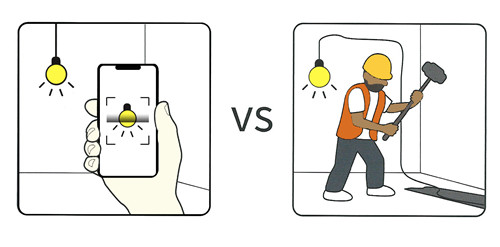
Table 1: Comparison of Construction Time and Cost of Wireless and Wired Systems
| Project | Wireless System | Wired System |
| Number of Low-Voltage Control Lines | 0 | 120m |
| Cabling and Trunking Speed (per person per day) | 0 | 40m |
| Cabling and Trunking Labor Cost (per meter) | 0 | 50 yuan/m |
| Time Required for Cabling and Trunking | 0 | 4 days |
| Cost for Cabling and Trunking | 0 | 6000 yuan |
B.Low Power Consumption
Smart lighting products are at the forefront of intelligent home hardware, where their power consumption plays a crucial role in determining the overall cost-effectiveness of the smart home system. Smart lighting excels in its cost-effective installation and usage. Wireless control during installation reduces the expenses related to numerous slots and wiring. During use, smart lighting effectively reduces electricity bills as it can adjust brightness based on different lighting scenarios, promoting energy efficiency. Additionally, standby power consumption in smart homes is a notable concern. Many people may consciously think that the standby power of smart homes is generally high, but in fact, thanks to the current ultra-low smart standby energy consumption technology, the standby power of some professional smart lamps can be as low as 0.1W.Table 2 provides a comparison of standby energy consumption between professional intelligent lighting systems and ordinary intelligent lighting systems, using the installation of 50 tube-type spotlights in a 120 m² three-bedroom and two-living room as an example.
Table 1: Comparison of Standby Energy Consumption of Professional Intelligent Lighting and General Lighting Products
| Project | Professional Intelligent Lighting System | General Intelligent Lighting System |
| Standby Power per Single Lamp | 0.1W | 1W |
| Standby Energy Consumption per Lamp per Year | 0.876 kWh | 8.76 kWh |
| Standby Electricity Consumption per Lamp per Year | 0.876 kWh | 8.76 kWh |
| Standby Electricity Consumption per Household per Year | 43.8 kWh | 43.8 kWh |
| Standby Electricity Cost per Household per Year (at 0.7 yuan/KWh) | 30.7 yuan | 306.6 yuan |
C.Meeting Different Needs
Lighting design is a very specialized field that must meet functional requirements, employing different lighting methods and lamps for various spaces, occasions, and objects to ensure proper illumination and brightness. Intelligent lighting designers consider the age of family members, living habits, and special requirements for lighting use to design scenes suitable for each family member. Additionally, the scene replacement of the intelligent lighting system can be changed by the designer or the user, making a set of lighting systems cater to the living needs of the entire family. This article introduces intelligent lighting design schemes for different groups of people (mothers and infants, children, students, the elderly) and intelligent lighting design schemes for different spaces (entrance, living room, bedroom, study room, dining room, bathroom, etc.) (Figure 8).
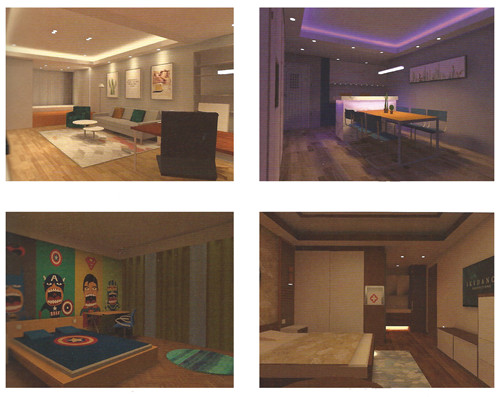
D. Comfort and health
We all know that the light environment will affect people’s health, mainly because the light environment will affect human hormone secretion and circadian rhythm. The light environment whose brightness is adjusted according to the law of people’s life is a safe and comfortable light environment. Through the adjustment of the light environment, people’s bodies and minds can be kept in the best state. For example, the light that slowly turns on in the morning simulates the sunrise to wake up our body and mind; the cool white light at 9 am injects energy into us so that we can focus on work; the warm yellow light at night allows us to relax from a busy day and embrace family life.
E. Diversified operation modes
In the development process of intelligent lighting, the control method is also constantly evolving. The traditional lighting control method is a single-open panel switch, which only controls the on and off of the light. Later, the knob dimmer switch can adjust the brightness of the lamp, and later developed to control the color temperature and brightness of the lamp by remote control. With the popularization of mobile devices and the development of artificial intelligence technology, the control method is more intelligent. As shown in Figure 9, the control through the mobile app and smart speakers has become the standard configuration of smart home products. In addition, although the wireless intelligent situational control panel and intelligent switch retain the traditional human-computer interaction method, they are more direct and convenient than mobile app operations. The way of wireless installation also makes the application scenarios of panels and switches more flexible.

F. Stable and Reliable System
System stability is one of the factors to consider when choosing smart home products. In terms of stability, an intelligent lighting system can meet the three basic requirements of stable product performance, stable system operation, and stable circuit structure, and it is a very qualified intelligent lighting system. There are two control methods of the intelligent lighting system: one is based on the Internet and interconnected with cloud background service data, and the other is based on local area network control. Through the local area network control, not only the response is faster, but also the control will not be affected even if the network is disconnected. Therefore, local LAN control is a more stable and reliable control method than cloud control.
3. Construction Steps of a Whole House Intelligent Lighting System
If you’re interested in setting up a smart lighting system for your entire home, there are two approaches you can take. The first option is to consult a professional smart lighting designer. The designer will engage in communication with you to understand your requirements and preferences. Based on this, the designer will provide a comprehensive home smart lighting system solution. This solution will include lighting design renderings, lamp layout diagrams, recommended lamp lists, smart linkage implementation plans, and more.
The following section will provide a detailed introduction to how a professional smart lighting designer develops a whole-house smart lighting system solution for users, along with the subsequent implementation and debugging steps (see Figure 10). It aims to be helpful to every reader who is eager to build a whole-house intelligent lighting system at home.
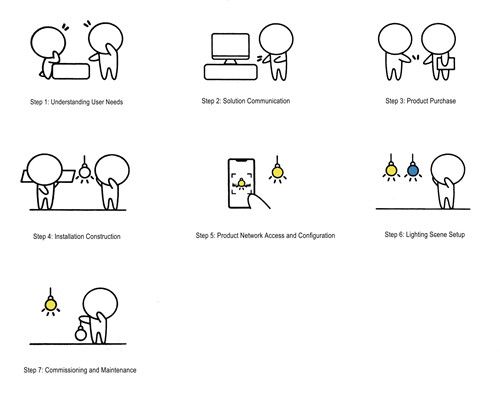
Step 1: Understanding User Needs
Understanding the true requirements of users can often be challenging. Therefore, effective communication between designers and users during the initial stage of the project is crucial. Users can explore a variety of scene effects at offline experience stores to better articulate their needs. Additionally, the designer will request the necessary floor plan from the user to use as a reference and will conduct a detailed inquiry about the user’s family members, lifestyle, personal preferences, and project budget. This information gathering process allows the designer to tailor a whole-house intelligent lighting solution that perfectly fits the user’s requirements.
Step 2: Solution Communication
Once the designer has thoroughly understood the user’s requirements, they will proceed to provide a comprehensive intelligent lighting solution. The designer will engage in continuous communication with the users, ensuring their satisfaction with the proposed solution. Typically, the designer begins by presenting the lighting effect diagram for the user’s reference (see Figure 11). Apart from traditional static renderings, smart lighting designers will incorporate dynamic scene renderings and smart lighting scene solutions (smart linkage solutions). This allows users to visualize the lighting scenes beforehand, enabling them to experience the effects.
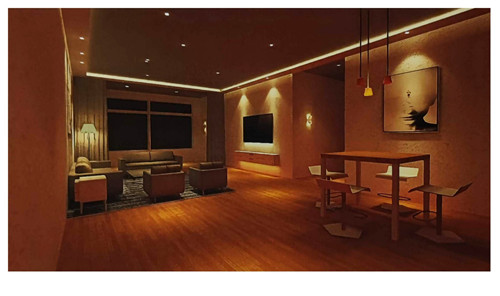
Moreover, during the design process, the designer utilizes professional lighting design software (such as DIALux) to generate a pseudo-color map of illuminance (see Figure 12).
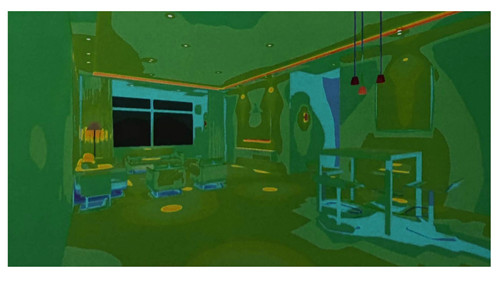
If the user expresses satisfaction with the proposed effect, the designer can then proceed to create a point map (also known as a lighting map) of the lamps, as depicted in Figure 13. The spot map of luminaires showcases the number of luminaires and their spatial distribution.
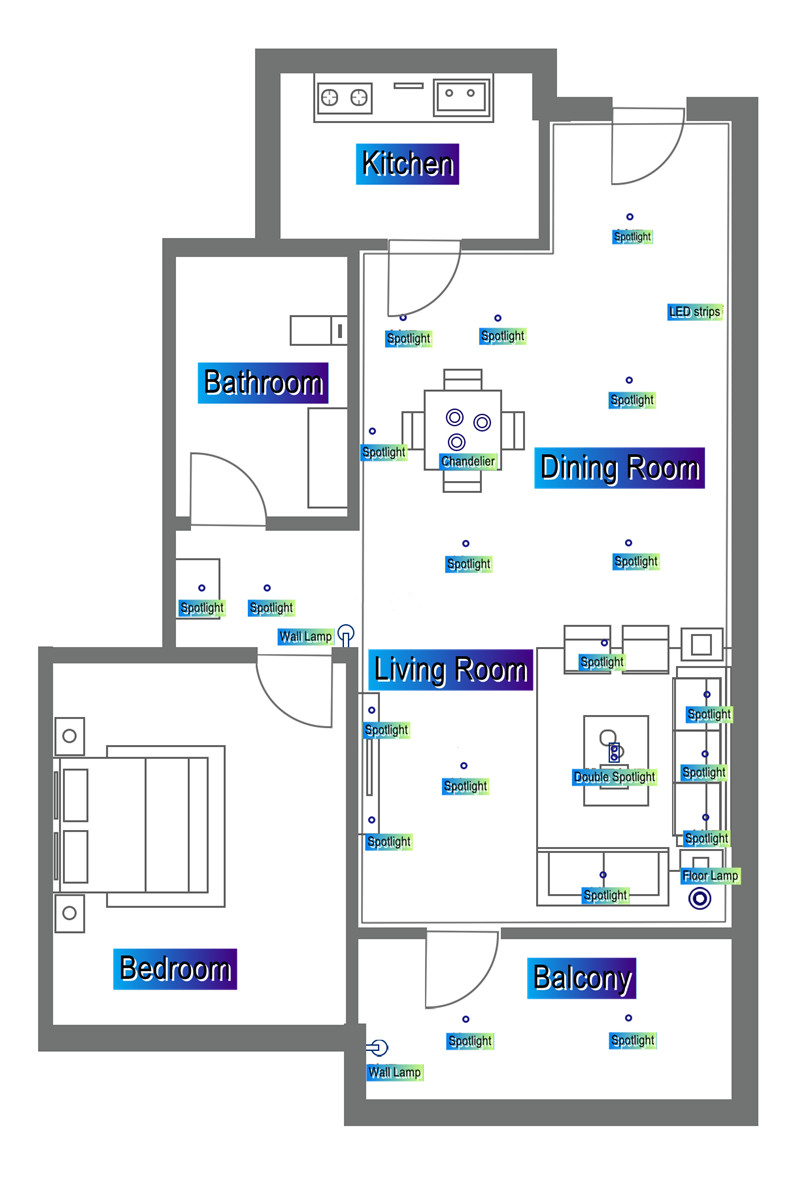
This comprehensive communication and visualization process ensures that users have a clear understanding of the proposed intelligent lighting solution and allows them to make informed decisions based on the presented options.
Step 3: Product Purchase
Once the design plan is finalized, the designer will present the user with a list of products required for the plan, taking into account the user’s budget. Additionally, the designer will recommend specific brands for the user to consider for their purchase. Once the user confirms the purchase plan and makes the payment, the designer will take the responsibility of procuring the products from the recommended brands on behalf of the user.
Step 4: Installation Construction
After the purchase is completed, the installer and configuration engineer will provide on-site service according to the time agreed with the user. The installer will install the required hardware products (lamps, switches, panels, etc.) in place according to the point map of the lamps.
Step 5: Product Network Access and Configuration
Once the installation master has successfully placed the hardware products, the configuration engineer will take charge. Their first task is to connect all the devices to the user’s home network and then associate them with the user’s smart home system App account. Subsequently, the user gains the ability to control each lamp individually, including adjusting color temperature, brightness, and setting up timing switches, among other functionalities.
Under normal circumstances, the App will provide step-by-step detailed operation guidelines during the process of connecting the products to the network, binding accounts, and configuring lamps for the first time. This enables users to easily follow the instructions and complete the setup at home.
Step 6: Lighting Scene Setup
The configuration engineer will proceed with the setup of smart lighting scenes for each space in the user’s home, following the smart lighting scene plan designed by the designer specifically for the user. This book mainly focuses on explaining how to configure smart lighting scenes at home. Users can follow the methods outlined in this article and make adjustments based on their own home’s layout and the preferences of family members.
In the upcoming article, we will provide detailed information about the most commonly used intelligent linkage configuration methods during the scene-building process.
Step 7: Commissioning and Maintenance
Upon completing the lighting scene configuration, the configuration engineer will thoroughly test and debug the whole-house intelligent lighting system. This ensures that the scene configurations are correct and all equipment operates stably.
In the event of any device failure or the need for configuration adjustments during the user’s usage, the designer or engineer can be contacted for remote diagnosis or on-site service. They will promptly address any issues, ensuring the smooth functioning of the intelligent lighting system and providing ongoing maintenance support as required.
4 How to Design Intelligent Lighting Linkage Scenes
A Design Principles of Intelligent Linkage Scenarios
People-Oriented, Practical, and Convenient
The fundamental goal of a smart home is to create a safe, comfortable, convenient, and efficient living environment for people. When it comes to smart home products, practicality takes precedence over flashy functions that merely serve as decorations. The emphasis should be on practicality, ease of use, and humanization. Therefore, when designing a linkage scene for a smart home, it is essential to prioritize these principles. If possible, visiting a smart home experience hall can provide a firsthand experience, helping individuals better identify and address their real needs.
Consider Hardware Costs Up Front
An essential factor in implementing smart linkage scenarios is the function and performance of smart devices. Generally, the same scene can be achieved using various combinations of devices. However, the quantity and performance of these devices play a significant role in determining the final scene experience and cost. Experience and cost are not always directly proportional, and users must find a balance between the two.
To enable more users to enjoy the benefits of smart lighting, this article includes multiple scene settings that offer both a professional version and an entry-level version. These two setting options come with different configuration methods and product costs, allowing readers to select the most suitable option according to their own needs.
Lightweight Configuration and User-Friendly Operations
A smart home utilizes various personalized control methods, such as local control, remote control, centralized control, mobile phone remote control, induction control, network control, and timing control. The primary goal is to simplify operations and enhance efficiency. However, if the operation and configuration processes become overly complex, users may become resistant to the system. Hence, when designing a smart home, utmost consideration should be given to the user experience, emphasizing convenience and intuitiveness in the operation. It is highly recommended to employ a graphic control interface, enabling a “what you see is what you get” approach, providing users with a more seamless experience.
B Smart Linkage Scenario Configuration Steps
Configuring intelligent linkage scenes is the final and crucial step in achieving scene automation. Depending on the types and quantities of purchased products, there are various ways to implement intelligent linkage. Similar to mathematical operations like addition, subtraction, multiplication, and division, or a programmer’s algorithm, setting step-by-step logic and clear rules lead to the desired outcome.
My family has been using the Xiaomi’s smart home system since 2017.In the following section, we will briefly introduce the configuration rules of smart linkage using Xiaomi’s smart home system as an example. However, the most effective way to understand these rules is to experiment and experience them firsthand.
Connect the device to the system
First, follow the instructions of the product instructions to connect the lamps, smart linkage devices (such as smart door locks, sensor speakers) and gateways to the smart home system.
Set the “If” Command of the Smart Linkage Rule
The intelligent linkage rules within the Xiaomi home system are primarily established using two commands: “if” and “execute”. The “if” command serves as the trigger condition for initiating the intelligent linkage, while the “execute” command represents the specific actions to be carried out. The “execute” command will only be executed if the conditions set by the “if” command are satisfied.
There are two types of “If” Commands.
The first type consists of general conditions, which can be set using four methods (note that the setting methods may vary depending on the mobile phone operating system): manual execution, leaving or arriving at a certain place, timing, and changes in outdoor weather.
The second type is the condition of the smart device. For instance, taking the smart door lock as an example, there are seven conditions.
Set the “Execute” Command of the Smart Linkage Rule
There are also two types of “execute” commands.
The first type includes general conditions, offering four setting methods (please note that the methods may vary depending on the mobile phone operating system): executing a certain smart action, switching a certain smart device, sending a notification to the mobile phone, and introducing a delay.
The second category pertains to the condition of the smart device. For instance, using the smart ceiling lamp as an example, more than a dozen conditions are available, which can be set as the “execute” command.
Both “if” and “execute” commands can be combined with multiple commands. When both “if” and “execute” are set, the basic configuration of intelligent linkage rules is complete.
Set the Effective Time of Smart Linkage
By default, the smart linkage is effective throughout the entire day. However, there are instances when we only wish to use it at specific times or on particular days. In such cases, we can adjust its effective time according to our preferences . Once this step is completed, the entire smart linkage scene is configured and can be used after saving.
